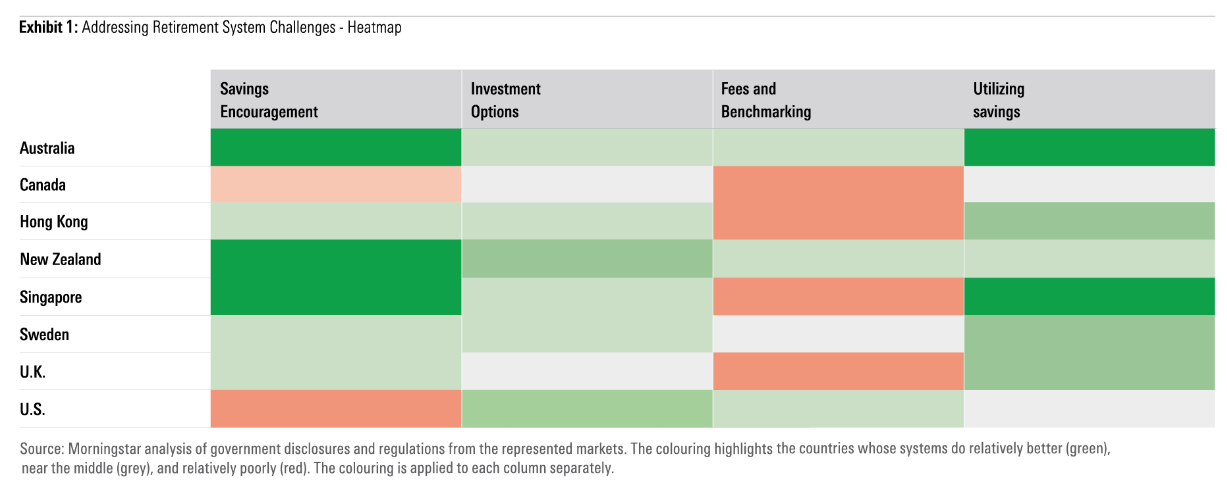
Investors in many markets are facing a common challenge: increasing responsibility for building savings to meet their needs in retirements that are lasting longer.
The fuel behind this fire comes from multiple sources: Public or social security pensions often provide no more than a basic retirement income, fewer companies are offering defined benefit schemes to their workforce, and people are simply living longer.
Most countries operate some form of a three-pillar retirement framework:
- a social security pillar;
- occupational- or workplace-related savings; and
- personal or individual savings.
Optimising each of the pillars and their interaction is crucial to ensuring positive retirement outcomes.
In a new paper, we specifically examine the second pillar and the workplace retirement systems in eight countries spanning the Americas, Europe, and Asia.
The countries—Australia, Canada, Hong Kong, New Zealand, Singapore, Sweden, the U.K., and the United States—all have effective retirement systems that are often cited in independent studies as among the best-in-class frameworks in their regions. Rather than attempting to rank them based on differences, which might overly emphasize one approach, we have elected to observe and highlight both best practices and areas for improvement across four key components, illustrating these visually in a heatmap.

Developing a Framework for the DC Transition
With many fewer workers covered by defined contribution than defined benefit plans, the Canadian workplace system is still transitioning to establish many of the best practices we see in other markets.
On the savings front, employers often contribute even if not mandated, sometimes in the form of a match that provides an incentive for employees to contribute as well. There are opportunities for the expansion of coverage and auto-enrolment in cases where a plan is offered, however the ability to move funds to a Locked-In Retirement Account when leaving an employer is a great way to keep funds in tax-advantaged accounts in reduce fragmentation.
When it comes to investment options, there can frequently be a large selection for employees to wade through in the lineup. While choice is good for supporting employees at different life stages and with different approaches, too much can create confusion and lead to naïve diversification.
As for fees and benchmarks, there is room for improvement, particularly from a transparency perspective. Canada consistently rates as one of the most expensive markets in which investors can save in Morningstar’s Global Investor Experience report, in part because the cost of advice is bundled into the products. It is difficult to assess if this experience is materially different within the retirement space as there is a lack of public data on what investments employees are using.
In terms of utilization of savings, some of the plan types available to Canadian workers allow flexibility for withdrawing assets before retirement to purchase a house or fund education. There are also options at and in retirement, as workers’ savings can be converted to annuities, taken out as lump-sums, or moved into the Registered Retirement Income Fund.
Move to Defined-Contribution Plans Highlights Individual Responsibility
We find that the defined-contribution (DC) scheme is already thriving in some markets and at a more embryonic stage in others. In large part, this is shaped by the extent to which social security pension schemes provide, or historically provided, a significant proportion of individuals’ retirement income.
A key tenet of the move to DC is that investment risk is put squarely on individuals. On top of that, workers must navigate a complex web of rules and options to optimise their savings. Getting unconflicted fiduciary advice to workers and retirees cost-effectively is a resulting challenge still eluding most countries.
How Much Choice is Too Much in Retirement Savings?
While choice is good, especially for experienced investors, too much choice is counterproductive, particularly for inexperienced investors. Some countries are better than others at optimizing plan choices so that participants are more likely to select a high-quality, low-fee investment or be defaulted into such an option.
In the same way that workers can be faced with too much choice within a plan, it’s also easy for them to accumulate multiple workplace plans and for that fragmentation to erode their savings. Minimizing the number of separate plans that individual workers have helps lowers costs and increases engagement. Countries have tried various approaches such as plan-follows-member, consolidating legacy plans into a ‘paid-up’ plan, and auto-transferring small, orphaned plans to an individual’s current or central plan.
How Countries Aim to Get People Saving Earlier
In the countries that have adopted them, auto-enrolment programs have been very effective at getting more people saving earlier. Plus, incremental changes to the programs continue to enhance the experience of more workers. We find a growing number of examples seeking to engage members as retirement approaches but a dearth of initiatives to engage younger people in retirement saving.
The long-term nature of retirement saving can paradoxically create a savings disincentive for workers deterred by introducing a barrier to accessing their savings. Some countries alleviate this to different degrees by allowing early access to retirement savings in certain circumstances, but there is a delicate balance between this and preventing people depleting their retirement income by using too much for other purposes.
Reducing Complexity as a Maxim
A common challenge we observed across heterogeneous retirement frameworks is complexity. They generally operate within complex rules and offer investment options that are not necessarily intuitive to inexperienced investors. Together, these factors make it challenging to ascertain how best to both accumulate, and then decumulate, retirement savings.
Overall, the hallmarks of the best-placed workplace schemes are government-mandated contributions; savings incentives, such as tax breaks or government contributions and employer-contribution-matching programs; and transparent oversight or benchmarking of scheme funds’ performance and costs.
















